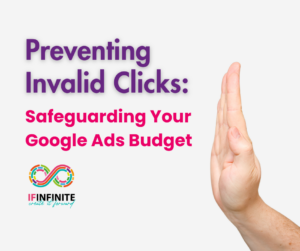Preventing Invalid Clicks: Safeguarding Your Google Ads Budget
What is draining your ads budget?!
Invalid clicks often get conflated with click fraud, mainly due to Google’s definition. According to Google, invalid clicks encompass any clicks on ads not stemming from genuine user interest, including deliberate fraud and accidental or duplicate clicks. However, this definition lacks nuance. Invalid clicks aren’t always malicious; they can also be unintentional. For example, a user might inadvertently open or double-click an ad, still counted as invalid. In contrast, click fraud involves the deliberate, malicious act of generating fake impressions to inflate costs for advertisers.
To shield your campaign ads budget from invalid clicks, consider implementing the following strategies:
Utilize Location Targeting:
Harness the power of location targeting to ensure your ad budget isn’t squandered. By focusing on specific geographic areas relevant to your business, you increase the chances of reaching potential customers likely to convert. Whether your business operates locally or targets specific regions nationally or internationally, leveraging location targeting optimizes your ad spend allocation.
Control Your Ads Budget Allocation:
Maintain oversight of your display campaign budget to prevent overspending and maximize efficiency.
Implement Dayparting:
Schedule ad displays during peak engagement times by leveraging dayparting. Aligning ad visibility with optimal timeframes enhances campaign effectiveness, minimizing wasted budget during low-conversion periods.
Target Specific Long Tail Keywords:
Opt for specific long-tail keywords to target users actively seeking products or services similar to yours. This focused approach attracts more qualified traffic, reducing wasted clicks from users in the early stages of the buying journey.
Optimize Landing Pages:
Enhance the quality of your PPC campaigns by optimizing landing pages. Mobile-friendly, visually appealing pages with clear calls-to-action improve user experience, reducing bounce rates and maximizing ROI.
Conduct A/B Testing:
Regularly conduct split tests to identify the most effective ad elements. By refining messaging, imagery, and calls-to-action based on test results, you optimize ad performance and minimize wasted spend.
Exclude Poor-Performing Placements:
Identify and exclude placements failing to meet business goals to streamline campaign effectiveness.
Continuously Add Negative Keywords:
Incorporate negative keywords to refine ad targeting and minimize irrelevant clicks. Utilize broad match negatives to exclude broader categories efficiently.
Adjust Bidding Strategy:
Consider adjusting ads budget bidding strategies to ensure optimal ad placement for higher conversion potential.
Set up IP Exclusions:
Identify and exclude suspicious IPs exhibiting high bounce rates or frequent non-converting clicks to mitigate click fraud.
Monitor Traffic Data:
Track traffic data vigilantly to detect and address suspicious activities promptly.
Leverage Google Analytics Alerts:
Utilize Google Analytics to set up alerts for anomalies in metrics like bounce rates and click-through rates, signalling potentially fraudulent activities.
Run Remarketing Campaigns:
Engage with legitimate visitors through remarketing campaigns to reduce the risk of click fraud and ensure effective ad targeting.
By implementing these strategies, you can fortify your Google Ads campaigns against invalid clicks, safeguarding your ads budget and maximizing ROI.
Need help is measuring and analysing your campaign optimisation? We are here to help! Contact us today.





